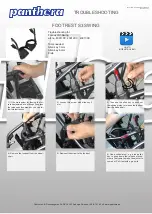
15
A
Figure 23
•
Move the bearing housing of the castor
wheel up or down (One-tool)
(see page 17)
Moving the bearing housing up lowers
the seat, and moving it down raises the
seat.
•
Move the castor wheel to a higher or
lower position in the castor wheel fork
Moving the castor wheel to a higher
position in the castor wheel fork (23A)
lowers the seat, and moving the castor
wheel to a lower position raises the
seat.
•
Changing to bigger or smaller castor
wheels
A smaller castor wheel reduces the
seat height, whilst a bigger castor
wheel increases the seat height. By
changing the castor wheel, a smaller
castor wheel will give a smaller turning
radius, and thereby increase the
ability to negotiate obstacles in narrow
spaces, and will also give more room
for the legs. A larger castor wheel will
increase the turning radius but will
also improve the ability to negotiate
obstacles on uneven surfaces.
•
Changing to a longer or shorter castor
wheel fork
A shorter castor wheel fork reduces
the seat height, gives a smaller turning
radius, and thereby increases the
ability to negotiate obstacles in narrow
spaces, and will also give more room
for the legs. A longer castor wheel fork
increases the seat height, and allows
several alternative castor wheels to be
used.
NB! Remember to adjust the
angle of the castor wheel when
you change the seat height.
Remember also to adjust the
brakes when adjusting the seat
height at the back.
Castor wheel fork
Castor
wheel
Bearing
housing
ADJUSTING THE WHEELCHAIR
Summary of Contents for Emineo
Page 1: ...MB3160 GB...
Page 40: ...40 10 20 19 18 16 15 13 12 11 9 8 6 5 4 3 2 1 23 17 22 21 7 ACCESSORIES...
Page 42: ...42 NOTES...
















































